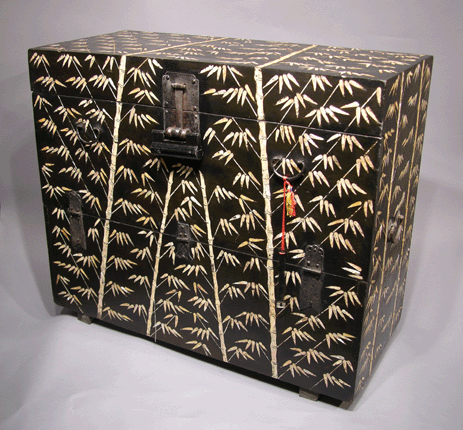m
 B
B
Ca 1860, Yi Dynasty; lime wood, bamboo motif, mother-of-pearl inlay; made for high-ranking court official; certified.
28½” h. 34¾ w. 15½” d.
This exquisite chest is inlaid with mother-of-pearl on bamboo motifs. Bamboo motif on this chest signifies loyalty to the King. Mother-of-pearl was a very expensive metal, and inlaying is very labor-intensive and costly, so this document chest must have been owned by a high official with connection to the imperial palace who somehow got into disfavor with the Court and was sent into exile. It was found after the Japanese Occupation on Kanghwa Island, a political prison colony for the Kingdom of Korea for two thousand years.
This is certified as a document chest instead of a clothing chest, a “bandaji” in Korea, perhaps because a bandaji traditionally has a half door opening outwards and downwards directly from the top of the chest, giving a wide opening to store clothing inside, whereas this chest has the door opening a little way down the front panel before opening downwards. The narrower opening is meant for the official to store documents, books, manuscripts, and other incidental personal items while he spent time at court. The fittings on this chest are made of iron, quite a common metal but favored by Buddhist era scholars for its purity and quiet strength.
This chest was recovered by an American missionary doctor who was invited to go to the prison colony to treat the sick and the dying. Furniture was not valued by the ruling scholar/official class, so the doctor was allowed to take away any furniture the exiled took with them to prison. For his humanitarian work, the doctor was honored with Korean citizenship. He spent the rest of his life in Korea. This chest was later passed on to a Korean Professor of Korean History and Antiquity, who certified this piece as quite rare. The chest is in excellent condition.